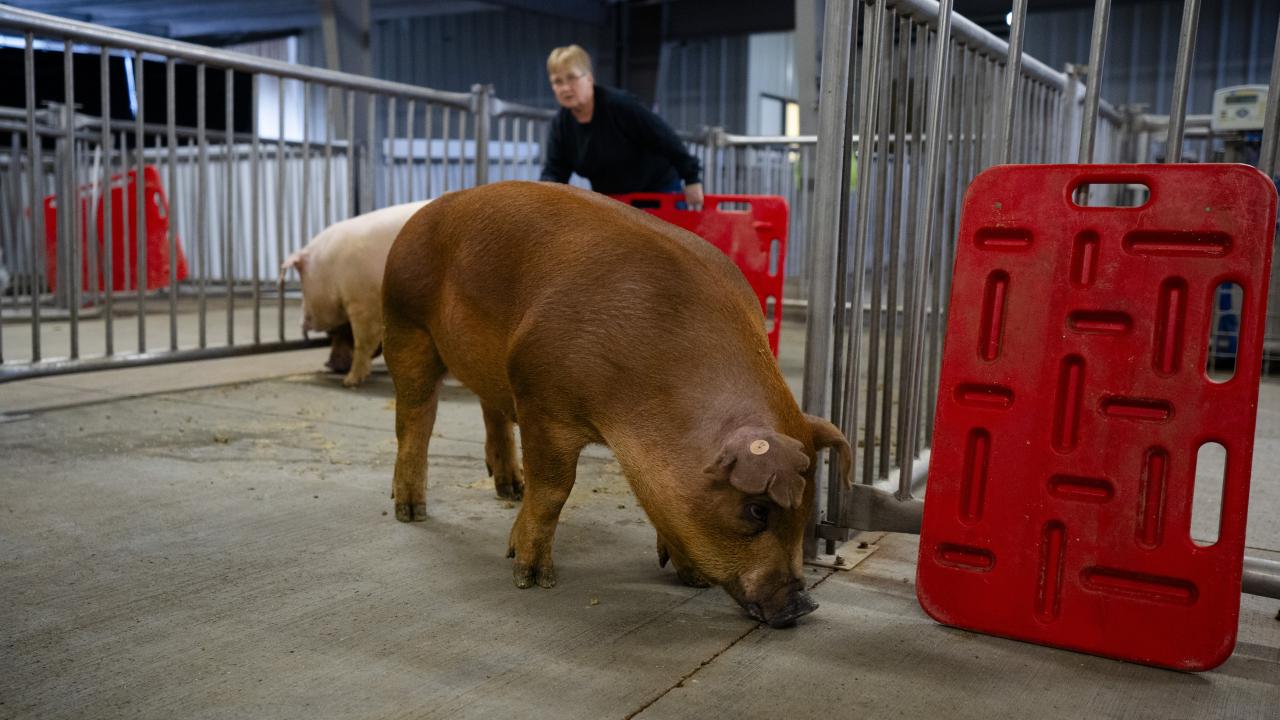
Using CRISPR Gene Editing to Combat PRRS Virus in Pigs
For over three decades, pork producers worldwide have grappled with the relentless threat of PRRS—a virus that not only harms pig health and welfare but also disrupts pork production, strains sustainability, and fuels antibiotic use by weakening pigs’ immune defenses. But with the help of the CRISPR technology, there may be a solution on the horizon.
First recognized in the United States in 1987, Porcine reproductive and respiratory syndrome virus (PRRS) is a highly contagious viral disease that affects pigs. Symptoms include reproductive failure, pneumonia and increased susceptibility to secondary bacterial infection. There are many strains of the virus, and some are more severe than others—which is why the symptoms of the disease can look very different from one case to another. It has become the most important disease in intensively raised pigs in North America and Europe. Each year, PRRS costs the United States $560 million by causing reproductive failure in adult females and deadly pneumonia in nursing pigs.
In addition, from 2016-20, PRRS was responsible for an estimated $1.2 billion loss per year in U.S. pork industry production, an 80% increase from a decade earlier, according to analysis by Iowa State University.
One solution to this devastating disease is the gene-editing breakthrough, CRSIPR, which would enable researchers to breed pigs that are genetically resistant to PRRS, offering a proactive, biological defense against the disease rather than relying on antibiotics or herd management alone. And in fact, research is being done at universities across the country to discover the how gene editing and CRISPR could help address the PRRS issue in pigs.
At UC Davis, Dr. Trish Berger, a distinguished professor in the Department of Animal Science, focuses her research on pigs and uses CRISPR to build thorough genetic data from gene-edited animals.
“CRISPR editing is a way where you can relatively easily succeed at eliminating a short segment of the DNA,” Dr. Berger said. “And by eliminating this short segment of DNA, you can eliminate a particular protein. So rather than going through generations and generations of selection and screening animals to find an animal that has a deletion in this protein, you can relatively easily eliminate it. Then you can study its effect, or you could use its absence to create an animal that is healthier, perhaps, which may seem surprising that you can delete a bit of DNA and make an animal that's healthier, but sometimes we can.”
Dr. Berger is focusing on whether or not the modified traits are consistently passed on to the next litter and across multiple generations. This is particularly important when it comes to a devastating disease such as PRRS.
“PRRS is a viral disease. It is a real welfare issue for pigs who are infected, they are sick. Some of them die. The ones that don't die are not healthy for a period of time, “Dr. Berger said.
For her, the use of CRISPR and gene editing in general has been a “gamechanger.”
“This technology where you can eliminate a particular gene is just incredible. It’s exciting,” Dr. Berger said.
What could this mean for producers and consumers?
For Producers:
- Addressing PRRS issue will allow producers to improve animal welfare and reduce the environmental impact of raising pigs.
- It will also reduce the need for antibiotic use to treat PRRS—the virus necessitates antibiotic use, which also results in higher veterinary care expenses and greater culling rates, all contributing to higher production costs per pig.
- It also could reduce the emotional stress of the constant threat of PRRS outbreaks, particularly in the reproductive form, which can be psychologically challenging for producers who work closely with pigs.
- In addition, the overall psychological pressure of the constant threat of PRRS outbreaks, particularly in the reproductive form, can be psychologically challenging for producers who work closely with pigs and are adversely affected by the loss of the pigs in their care.
For Consumers:
If researchers could help solve the PRRS problem in pigs, the effects on consumers would be significant:
- More affordable pork: PRRS causes major economic losses due to pig illness, reduced productivity, and increased veterinary costs. Reducing or eliminating PRRS would lower production costs, which could lead to more stable or lower pork prices at the grocery store.
- Improved animal welfare: Healthier pigs mean better living conditions—something many consumers value when making food choices.
- More sustainable pork production: Fewer sick animals mean more efficient use of resources (like feed, water, and land) and reduced need for antibiotics or intensive care, making pork production more environmentally and ethically sustainable.
- Greater food security: With fewer losses to disease, producers can supply more consistent quantities of pork, helping to ensure a reliable food supply.
The Future of PRRS, Gene Editing and Consumer Demand
On April 30th of this year, the U.S. Food and Drug Administration (FDA) approved the use of a gene-editing technology that creates pigs resistant to the highly contagious and costly porcine reproductive and respiratory syndrome (PRRS). A research group based at The Roslin Institute used their expertise in gene editing techniques to produce the PRRS-resistant pigs. The American Association of Swine Veterinarians (AASV) has come out in support of this decision and broadly endorses the responsible use of gene editing technologies to improve swine health and welfare—provided it’s done under rigorous safety protocols and strong ethical oversight.
Dr. Berger, who didn't work on the research to produce the PRRS-resistant pigs, recognizes just how important these findings could be for producers and animal health.
“So, the FDA recently approved, after many years, a gene edit, which was a deletion that reduces the sensitivity and the susceptibility of pigs to PRRS,” Dr. Berger said. “The investigators discovered that if they simply eliminated part of a single protein that served as a receptor. (The virus bound to this receptor on cells and entered the cells.) If you eliminated this one protein, the virus couldn't enter the cells, it couldn't infect the cells. The pigs would not be susceptible. Apparently, this, by eliminating this protein, you can eliminate 99% of the viruses for PRRS in terms of their ability to infect the cell.”
And in trying to meet the consumers where they are, a survey was conducted by PIC (Pig Improvement Company) and participants across the U.S., ages 18-70 were asked if they would be receptive to purchasing gene-edited pork. After reading a description of gene editing in food and the PRRS-resistant pig, 72% of consumers like the idea of the PRRS-resistant pig and its benefits.
In the fight against PRRS—a costly and devastating disease in pigs, gene editing offers a promising path forward. By precisely editing the pig genome to remove or alter the receptors that the virus uses to enter cells, researchers are working toward creating animals that are resistant to infection. While more research and regulatory steps lie ahead, early results are encouraging and signal a future where gene-edited pigs could dramatically reduce the need for antibiotics and dramatically improve animal welfare.
Questions and Answers:
Q: What is PRRS and why is it such a big problem?
A: PRRS (Porcine Reproductive and Respiratory Syndrome) is a serious virus that affects pigs. It causes reproductive failure in adult pigs and severe pneumonia in young ones. It weakens pigs' immune systems, leads to high vet costs, and contributes to antibiotic use. There is no cure for PRRS.
Q: How can CRISPR help with PRRS?
A: CRISPR is a gene-editing tool that lets scientists make very precise changes to DNA. In the case of PRRS, researchers used CRISPR to remove a specific part of the pig's (CD163) protein that the virus needs to infect pigs. Without that protein, the virus can’t get in—and pigs stay healthy.
Q: How does gene editing with CRISPR improve upon traditional breeding methods?
A: Unlike traditional breeding, which takes many generations to select for desirable traits, CRISPR can quickly and precisely remove or modify a gene, speeding up the process of developing disease-resistant pigs.
Q: Is gene-edited pork safe to eat?
A: Yes. In April 2025, the FDA approved the use of gene-edited pigs resistant to PRRS after a careful review. Experts, including veterinarians and researchers, agree that the pork is safe, nutritious, and no different in taste or quality.
The CLEAR Center receives support from the Pork Checkoff, through the National Pork Board.
